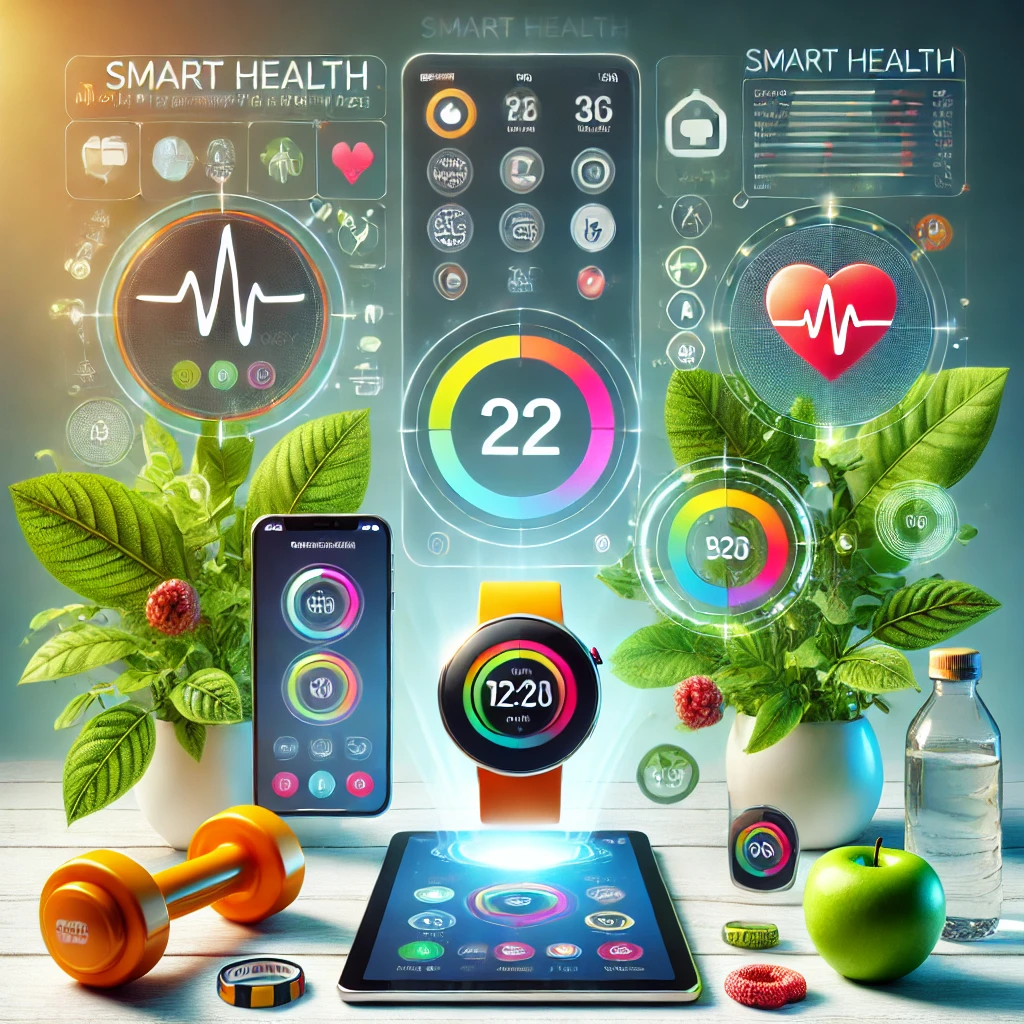Smart Health Tech: The Essential Guide to Using Apps and Devices for Better Health
With advancements in digital technology, staying healthy has become easier and more accessible than ever. From fitness tracking and sleep monitoring to personalized nutrition and mental health support, smart health tech provides powerful tools that help you make informed decisions about your health. This guide covers the essentials of using health apps and wearable devices to support your wellness journey.
1. Understanding Smart Health Technology
Smart health technology encompasses a range of digital devices, applications, and tools designed to monitor, analyze, and enhance various aspects of health and well-being. Whether you’re looking to track your steps, manage chronic conditions, or improve mental clarity, smart health tech offers personalized solutions.
Key Areas of Smart Health Tech:
- Wearable Devices: Devices like fitness trackers, smartwatches, and health-monitoring gadgets that provide real-time health data.
- Health Apps: Mobile applications that support areas such as fitness, nutrition, mental health, and condition management.
- Telemedicine: Virtual healthcare services that allow you to consult with healthcare providers remotely.
- Home Diagnostics: Devices like blood pressure monitors, glucose meters, and at-home test kits for health tracking and diagnostics.
2. Fitness and Activity Tracking
Fitness trackers and smartwatches are among the most popular devices for tracking physical activity. These devices measure steps, calories burned, heart rate, and more, helping you stay accountable to your fitness goals.
- Popular Devices: Fitbit, Apple Watch, Garmin, and Whoop.
- Key Features:
- Step Counter: Measures steps taken, encouraging daily movement.
- Heart Rate Monitor: Monitors heart rate during workouts and at rest, offering insights into cardiovascular health.
- Calorie Tracking: Estimates calories burned based on activity level.
- GPS Tracking: Tracks routes and distance for outdoor activities like running or cycling.
- Advanced Tracking Options: Some devices monitor VO2 max, stress levels, and recovery, offering insights for athletes and fitness enthusiasts.
Using Fitness Apps
Most devices are compatible with fitness apps, where you can set goals, track progress, and even participate in social challenges. Popular fitness apps like MyFitnessPal, Strava, and Nike Training Club provide customizable workouts and nutrition tracking for a comprehensive fitness approach.
3. Sleep Tracking and Optimization
Getting quality sleep is essential for physical and mental health. Sleep tracking devices analyze sleep duration, quality, and patterns to help you understand and improve your sleep habits.
- Popular Devices: Oura Ring, Fitbit, Apple Watch, Withings Sleep Mat.
- Key Features:
- Sleep Stages: Tracks light, deep, and REM sleep cycles.
- Sleep Score: Offers a sleep quality score based on movement, heart rate, and time spent in each sleep stage.
- Smart Alarms: Wakes you up during the lightest sleep stage for a more refreshing start.
- Sleep Environment Tracking: Some devices monitor room temperature, humidity, and noise levels to help you optimize your sleep environment.
Using Sleep Apps
Apps like Sleep Cycle, Calm, and Headspace provide insights and suggestions to improve sleep quality. Many sleep apps offer guided sleep meditations, white noise options, and sleep tracking to promote restful sleep.
4. Nutrition and Diet Management
Nutrition apps and smart devices make it easy to track food intake, monitor hydration, and plan meals tailored to your health goals.
- Popular Apps: MyFitnessPal, Cronometer, Yummly, and Noom.
- Key Features:
- Calorie and Macronutrient Tracking: Logs meals and breaks down calories, proteins, fats, and carbs.
- Food Database: Offers extensive databases with calorie and nutrient info for thousands of foods.
- Meal Planning: Many apps provide meal plans based on dietary preferences, restrictions, and health goals.
- Hydration Reminders: Tracks daily water intake to ensure you stay hydrated.
- Customizable Goals: Allows you to set and monitor goals for weight loss, muscle gain, or maintenance.
Smart Kitchen Devices
Devices like smart scales and connected food processors can integrate with apps to provide accurate portion sizes and nutritional breakdowns, making it easier to maintain a balanced diet.
5. Mental Health and Wellness Apps
Mental health apps and smart devices offer tools to manage stress, track mood, and practice mindfulness, helping you maintain emotional well-being.
- Popular Apps: Headspace, Calm, Happify, Moodfit, and Wysa.
- Key Features:
- Guided Meditation and Mindfulness: Offers audio and video sessions for relaxation, focus, and stress reduction.
- Mood Tracking: Logs daily emotions and stress levels to help identify patterns and triggers.
- Cognitive Behavioral Therapy (CBT) Exercises: Some apps, like Wysa, offer CBT techniques to cope with anxiety and depression.
- Breathing Exercises: Guides users through breathing techniques to reduce stress and improve focus.
- Sleep and Relaxation Sounds: Provides sleep-inducing sounds and music for better sleep and relaxation.
Wearable Stress Trackers
Devices like Fitbit and the Garmin Vivosmart offer stress-tracking features that monitor changes in heart rate variability (HRV) to detect stress. Paired with mental health apps, these devices can alert you to practice mindfulness when stress levels are high.
6. Health Monitoring for Chronic Conditions
For individuals with chronic health conditions, there are specialized apps and devices designed to monitor symptoms, medication, and treatment adherence.
- Diabetes Management: Devices like the FreeStyle Libre and Dexcom offer continuous glucose monitoring. Paired with apps, they provide real-time glucose readings and alerts.
- Blood Pressure Monitoring: Smart blood pressure monitors, like the Omron Platinum, allow users to check and log blood pressure from home.
- Asthma and Respiratory Health: Devices like Propeller Health connect to inhalers and track medication use, helping users manage asthma.
- Heart Health: Devices like the KardiaMobile and Apple Watch offer EKG capabilities to detect irregular heart rhythms, which can be critical for people with atrial fibrillation.
Medication Tracking Apps
Apps like Medisafe and MyTherapy help patients manage medications, providing reminders for doses, refill alerts, and tracking for side effects.
7. Telemedicine and Virtual Health Consultations
Telemedicine has made healthcare accessible from the comfort of your home. Many telemedicine platforms and health apps allow you to schedule appointments, video chat with doctors, and access prescriptions online.
- Popular Telemedicine Apps: Teladoc, Amwell, Doctor on Demand, and MDLive.
- Key Features:
- Video Consultations: Connect with doctors for consultations on non-emergency issues.
- Prescription Management: Some telemedicine apps offer prescription refills and delivery.
- Access to Specialists: Many platforms provide access to specialists, including dermatologists, therapists, and pediatricians.
- Remote Monitoring: Some telemedicine services integrate with wearable devices to monitor vital signs during consultations.
8. Privacy and Data Security in Smart Health Tech
As with any technology, privacy and data security are paramount. When using health apps and devices, be aware of data sharing practices and privacy settings.
- Data Encryption: Choose apps and devices that encrypt data both on the device and in the cloud.
- Privacy Policies: Read the privacy policy to understand how your health data will be used and shared.
- Permissions: Limit app permissions to only the necessary data, such as location or contacts.
- Two-Factor Authentication: Opt for two-factor authentication on health apps to prevent unauthorized access.
9. Making the Most of Your Smart Health Tech
With so many options, it’s essential to choose devices and apps that suit your specific health goals. Here’s how to make the most of your smart health tech:
- Set Clear Goals: Define what you want to achieve—whether it’s improving fitness, managing stress, or monitoring a chronic condition.
- Customize Alerts and Reminders: Use reminders for hydration, movement, and medications to stay on track without becoming overwhelmed.
- Review Your Data Regularly: Use weekly or monthly summaries to track progress and identify trends.
- Stay Consistent: Consistency is key. Regular use of these tools enhances their effectiveness and keeps you informed about your health.
10. Summary: The Future of Smart Health Technology
Smart health tech is revolutionizing healthcare by making personalized health management accessible and easy to integrate into daily life. By choosing the right apps and devices, you can improve fitness, monitor vital signs, manage chronic conditions, and even improve mental well-being. As technology continues to evolve, expect even more personalized and proactive health solutions that empower you to lead a healthier, happier life.
Smart health technology offers a wealth of tools and insights to help you take control of your wellness journey. By leveraging the power of digital health, you can achieve a deeper understanding of your body, make informed decisions, and work toward your health goals with confidence.



